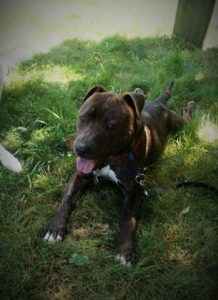
Lilo shows off a crowd favorite, her “t-rex” move. What’s cuter than seeing a t-rex at the beach?! Courtesty of our friends at Bully & Blaze.
Teaching your pet a new trick has far more benefits than the obvious adorable factor. It also improves the communication skills you have with her, helps build confidence, provides a mental workout, and equips you with another tool you can use to diffuse stress in your pet by asking her to “perform” as a distraction. Bonus: other people love it and creates a great impression!
So what is positive reinforcement?
Simply put, positive reinforcement is rewarding a behavior that you want your pet to do. Food is the most common form of praise since most animals respond strongly to it. Yes, that means you can use positive reinforcement to train many species of pets! Most people are aware of the basics of positive reinforcement training since it is commonly used to train puppies and at obedience class. Some important factors with positive reinforcement are:
- timing: a behavior (i.e. “sit”) needs to be rewarded quickly. Be sure you are rewarding the sit and not the motion of her standing up from the sit! Positive reinforcement is also when your pet nudges you for attention and you give the reward of attention. You have now taught her nudging gets her the attention she was seeking!
- verbal cues: keep commands and praise simple, such as “sit” and “yes” (the word you would give with the treat so that once the behavior is learned, it can become the praise/reinforcement).
- consistency: a reward every time the animal does something is money in the bank. It creates a clear expectation and she’ll want to keep offering the behavior when asked.
Reputable organizations like the Humane Society and renowned trainer Victoria Stilwell have more in-depth information on positive reinforcement that you can read by clicking on the links.
Ways to use positive reinforcement
- When your pet does the behavior organically, capture the moment with a reward and assign a word to the action. For example, my in-laws taught their cat to sit by saying “sit” when he did so on his own and giving him a tasty treat. Treat in hand, they could easily ask him to “sit” when guests came over even though he generally hid when people visited.
- When you utilize your pet’s desire for a reward (usually a treat but whatever works for your pet – a toy, ball, etc.) to get her to follow the reward into a desired position or action, you have used the luring technique. Taking a treat and holding it just above a dog’s nose and slowly moving it in a straight line towards her back so that she sits as a result of trying to follow the its movement is a very common example of this.
Both are popular ways to train basic commands and fall under the umbrella of a technique called shaping, that you can read a lot more about in this great article from the Whole Dog Journal. The idea of shaping is to take a desired behavior and to break it down into smaller, teachable components. This is great if a dog is struggling with a behavior (i.e. squeaks towards “down” but never quite makes it so she is rewarded for incremental improvements til she reaches a complete “down”) or a complicated routine. It is also a useful technique for making them use their noggin!

Ty shows off her “up and stay.” She readily climbed rocks on her on. By attaching a command (“up”) then adding one she already knew (“stay”), I can ask her to take some epic poses!
Let’s teach “crawl”
If your pet already does a crawl maneuver, you’re ahead of the game! When she does it on her own, say “crawl” (or whatever you choose to call the behavior) and give her a treat. She will begin to attach the word to the behavior and the fact that she gets a treat for doing it.
To start from scratch, start by placing your pet in “down.” Then hold a tasty treat on the ground at a distance she can barely reach but not take it and drag it very slowly across the floor. Start very small since it is likely she may try to stand up and take the treat. If that happens, calmly place her back in “down” without giving her the treat and try again. When she crawls, give her the treat and say “crawl.” Do this for a short distance until she gets the hang of it then slowly increase how far you ask her to go for the treat. This may take a couple sessions or many. Remember to reward her while she is still in the crawl position. This will be in the form of a treat for awhile but you’ll also want to introduce a clicker or word such as “yes” that also tells her she has done the correct behavior. Later, the word or clicker can be used in lieu of a treat. You can learn more about clicker training here.
One enormously useful command that is taught through shaping is “place.” This instructs your pet to go to a designated spot (usually a mat or their bed) until released. This can be used when guests arrive, dinner time, to create space between pets when needed, and a host of other scenarios. Towards the end of the Whole Dog Journal article, they explain how to teach “place.”
Positive reinforcement training has become a way of life for many trainers and pet owners for it’s scientifically proven, long term effectiveness, ability to raise a dog’s confidence, and humane nature. Teaching a trick is inherently intended to be a fun task but positive reinforcement can be used for so much more to make your life and your pet’s more enjoyable!



Recent Comments